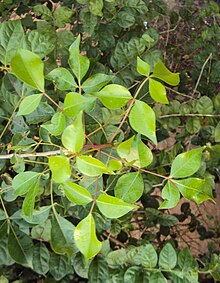
Back Commiphora Afrikaans ከርቤ Amharic بلسان Arabic شجرة البخور ARZ Kommifora Azerbaijani کومیفورا AZB Commiphora Byelorussian Commiphora Catalan Commiphora CEB Myrhovník Czech
| Commiphora | |
|---|---|

| |
| Commiphora caudata | |
| Scientific classification | |
| Kingdom: | Plantae |
| Clade: | Tracheophytes |
| Clade: | Angiosperms |
| Clade: | Eudicots |
| Clade: | Rosids |
| Order: | Sapindales |
| Family: | Burseraceae |
| Genus: | Commiphora Jacq. (1797) |
| Species | |
|
ca. 190. See text. | |
| Synonyms[1] | |
| |

The genus of the myrrhs, Commiphora, is the most species-rich genus of flowering plants in the frankincense and myrrh family, Burseraceae. The genus contains approximately 190 species of shrubs and trees, which are distributed throughout the (sub-) tropical regions of Africa, the western Indian Ocean islands, the Arabian Peninsula, India, and South America.[2][3][1] The genus is drought-tolerant and common throughout the xerophytic scrub, seasonally dry tropical forests, and woodlands of these regions.
The common name myrrh refers to several species of the genus, from which aromatic resins are derived for various fragrance and medicinal uses by humans.
- ^ a b "Commiphora Jacq. | Plants of the World Online | Kew Science". Plants of the World Online. Retrieved 1 October 2023.
- ^ Daly et al. 2011. Burseraceae. Families and genera of vascular plants. 10:76–104.
- ^ Weeks, A. and Simpson, B.B. 2007. Molecular phylogenetic analysis of Commiphora (Burseraceae) yields insight on the evolution and historical biogeography of an “impossible” genus. Molecular Phylogenetics and Evolution. 42:62–79.
© MMXXIII Rich X Search. We shall prevail. All rights reserved. Rich X Search